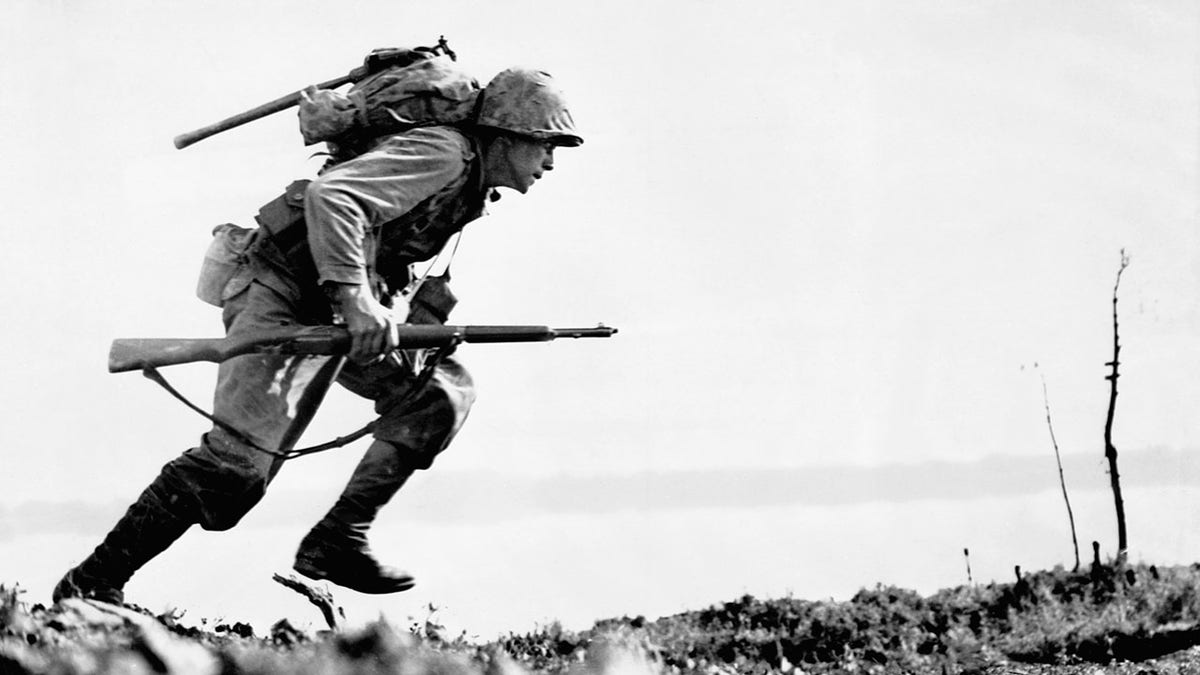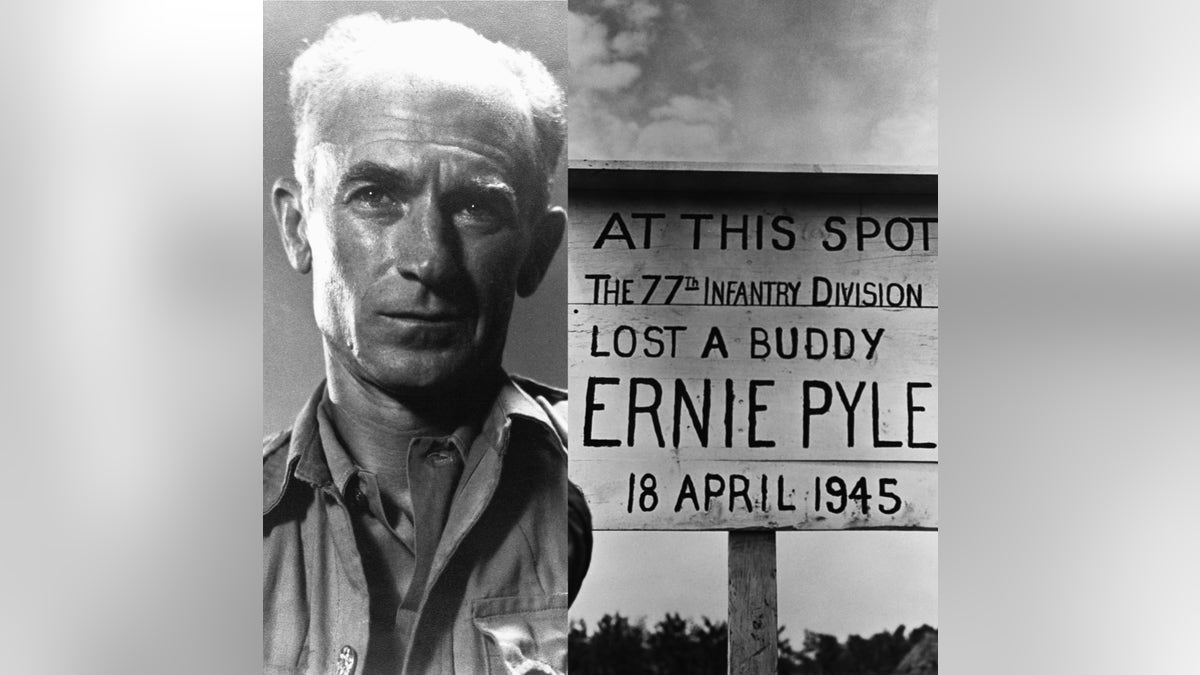Vermont woman receives cache of World War II-era letters written by her parents
Carol Bohlin of Vermont, 75, received a package of letters that her parents sent to each other while her father was serving in the U.S. Navy nearly 80 years ago. Watch her read aloud from these remarkable letters that had been hidden away in a wall.
The United States launched a massive invasion of the Japanese home island of Okinawa, with an initial landing of 60,000 soldiers and marines, on this day in history, April 1, 1945.
The Battle of Okinawa proved the last major engagement of World War II and the largest battle of the entire war in the Pacific Theater.
Kamikazes, mass civilian suicide, the use of children in combat, the deaths of top-ranking officers and atrocious casualties on both sides defined the nearly three-month-long brutal engagement, which ended in U.S. victory on June 22.
ON THIS DAY IN HISTORY, MARCH 31, 1943, ‘OKLAHOMA!’ DEBUTS ON BROADWAY: ‘DEEPLY FELT’
Its catastrophic battle had a dramatic impact on the shape of the world to come — convincing President Truman that the atomic bomb would hasten the end of the war and save millions of lives.
"Although the joint Army-Marine Corps landings on Okinawa were initially unopposed, the well dug-in Japanese defenders soon put up fierce resistance," writes the National World War II Museum.

U.S. landing craft arrived on Okinawa 13 days into the American invasion, which began on April 1, 1945. (History/Universal Images Group via Getty Images)
"Taking Okinawa would provide Allied forces an airbase from which bombers could strike Japan and an advanced anchorage for Allied fleets. From Okinawa, U.S. forces could increase air strikes against Japan and blockade important logistical routes, denying the home islands of vital commodities."
The conquest of Okinawa, with its population of about 300,000 people, proved a horrific challenge.
"GIs watched in horror as civilians leaped to their deaths over the cliffs of Okinawa, often with their children by their side or in their arms."
"By the time Okinawa was secured by American forces on June 22, 1945, the United States had sustained over 49,000 casualties, including more than 12,500 men killed or missing," reports the National World War II Museum.
It adds, "Okinawans caught in the fighting suffered greatly, with an estimate as high as 150,000 civilians killed" — about half the pre-invasion population of the island.

A U.S. Marine from the 2nd Battalion, 1st Marines on Wana Ridge, firing a Thompson submachine gun. Battle of Okinawa, May 1945. (Pictures from History/Universal Images Group via Getty Images)
American war planners were shocked by the fanatical suicides of both civilians on the island and kamikaze pilots attacking U.S. warships supporting the invasion.
D-DAY 78 YEARS LATER: HOW FDR'S POWERFUL PRAYER UNITED AMERICANS
Many GIs watched in horror as civilians leaped to their deaths over the cliffs of Okinawa, often with their children by their side or in their arms, rather than face U.S. troops.
One area of Okinawa is still known today as Suicide Cliff.

Okinawa, Japan: Eleven Okinawa civilians who were huddled in this hillside cave were rescued when a passing Marine patrol heard a baby crying. After they were assured that no harm would come to them, they emerged from their hideout; here, a leatherneck lends a hand to a mother and baby. (Official U.S. Marine Corps photo via Getty Images)
"Many civilians, often entire families, committed suicide rather than surrender to Americans, by some accounts on the orders of fanatical Japanese soldiers," Reuters reported in a 2007 anniversary story of the Battle of Okinawa.
"We were told that if women were taken prisoner we would be raped and that we should not allow ourselves to be captured," one survivor told the news outlet.
"Many civilians, often entire families, committed suicide rather than surrender."
"Four of us tried to commit suicide with one hand grenade, but it did not go off."
Japan launched its first kamikaze attacks in 1944 in the Battle of Leyte Gulf. But the horrifying suicide onslaught reached its deadliest fever pitch at Okinawa.
The Japanese launched 1,900 kamikaze attacks during the Okinawa campaign, according to the National Museum of the U.S. Navy.

A U.S. Marine charges forward through Japanese machine gunfire on Okinawa. Marines and infantry of the U.S. 10th Army controlled three-quarters of Okinawa three weeks after landing on the island. (Photo by © CORBIS/Corbis via Getty Images)
They struck 149 American ships, leaving nearly 10,000 Americans dead, wounded or missing.
The intense battle claimed the lives of the top-ranking soldiers on both sides of the conflict.
"This was the only battle in the Pacific War [in which] both commanding generals were killed," wrote Michael A. Eyre for Texas A&M University Corpus Christi.
"The Japanese commander, General Ushijima, committed harikari and his American counterpart, Lieutenant General Buckner, was killed by mortar fire. Buckner was the highest ranking American officer to be killed in World War II. This demonstrates the significance and ferocity of the fight for Okinawa."

USS Bunker Hill is hit by two kamikaze pilots during the Battle of Okinawa, Japan 1945. (Universal History Archive/Universal Images Group via Getty Images)
Perhaps the most famous person killed on Okinawa was celebrity U.S. war correspondent Ernie Pyle, who chronicled the war in both Europe and Asia and won the acclaim of American troops for his front-line reporting.
CLICK HERE TO SIGN UP FOR OUR LIFESTYLE NEWSLETTER
The 44-year-old Indiana native was killed instantly when he was shot in the head by enemy machine gun fire on April 18.
"Soldiers built a coffin for their friend and buried him along with the others killed on Ie Shima," reports the Indiana Historical Society.
"About 200 men from all ranks and representing all parts of the armed forces attended the burial service held on April 20, which lasted about 10 minutes."

Famed World War II correspondent Ernie Pyle was killed on Okinawa on April 18, 1945. American troops held a service in his honor two days later. (Getty Images)
The impact of the Battle of Okinawa is still being felt today.
"The losses at Okinawa convinced U.S. war planners that any invasion of Japan would incur unacceptable casualties," writes the Imperial War Museum of London.
CLICK HERE TO GET THE FOX NEWS APP
"Their estimates, at worst as many as 1 million U.S. servicemen, were a key factor in President Truman's decision to use the atomic bomb."
For more Lifestyle articles, visit www.foxnews.com/lifestyle.





















